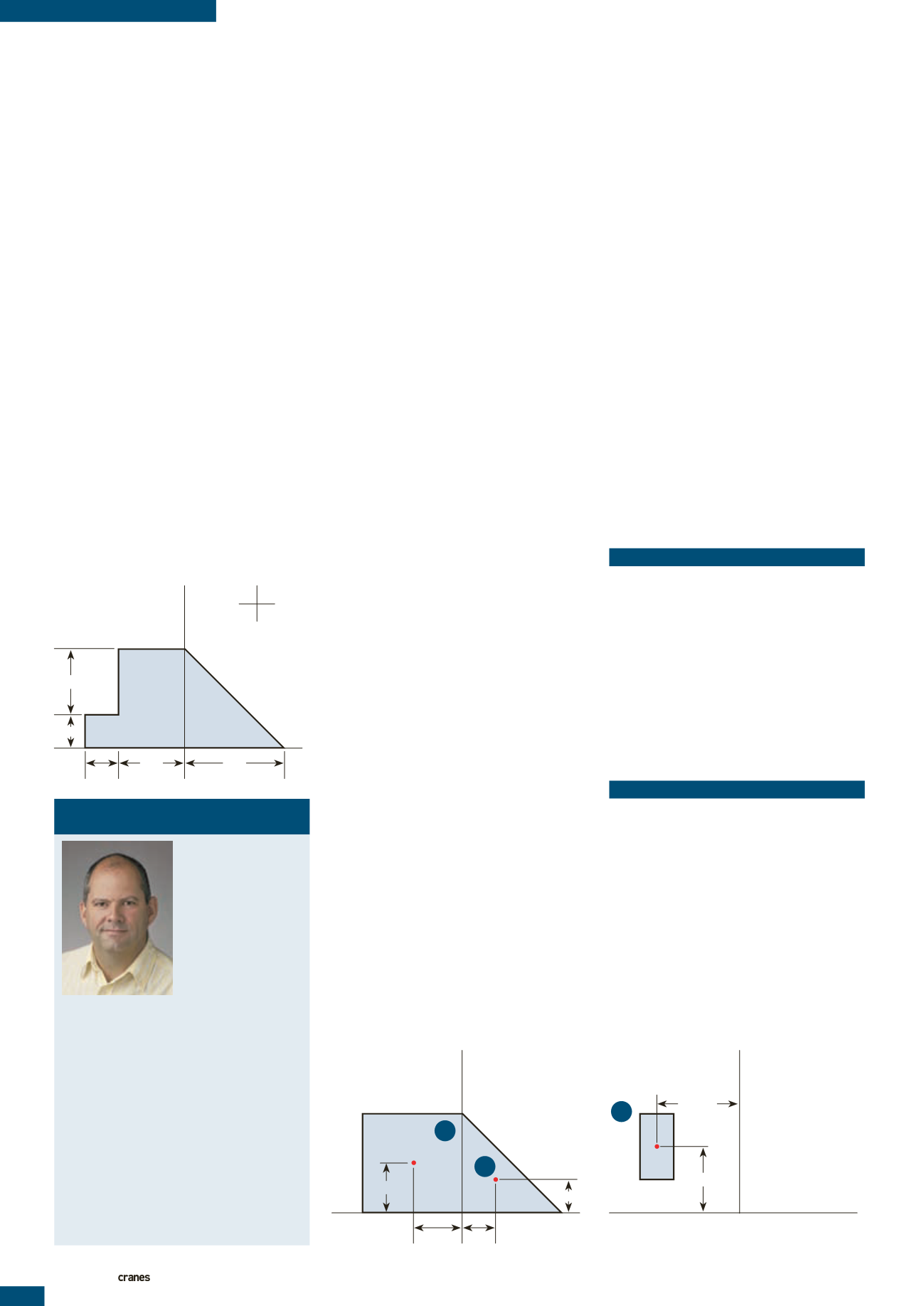
THE KNOWLEDGE
INTERNATIONAL AND SPECIALIZED TRANSPORT
■
DECEMBER 2013
36
Central focus
A topic central in more
ways than one both to
lifting and transport
operations is centre of
gravity. CoG can be an
issue that makes or
breaks a project, writes
MARCO VAN DAAL
Finding out
Let’s start the exercise with a simple way
of determining the centre of gravity.
This method can be applied to every
object of which the CoG needs to be
determined. Observe
Figure 1
, this is a
two-dimensional object, for example, a
steel plate with a random shape, for which
the CoG needs to be determined. This
cannot be done in one step, but has to be
performed in a series of separate steps.
NOTE:
the distances are given in metres but
this can be any unit of measure: feet, yards,
etc. For the results of the calculation this
makes no difference.
STEP 1
Choose the location of the x-axis and
the y-axis. These can be chosen in any
location because the outcome will remain
the same if these axes are chosen in a
different location. Try it.
For this example in Figure 1 the
x-axis is chosen at the base of the object
and the y-axis is chosen so that it runs
straight down between the triangular and
rectangular shapes.
STEP 2
Choose which side of the x-axis is the
positive side and which one is the negative
side. This is necessary because a 1 metre
distance from the y-axis could be on either
side and without the “+” or “-” designation
there is no way of knowing this and, by
definition, the outcome of the calculation
will be wrong.
ABOUT THE AUTHOR
Marco van Daal has
been in the heavy
lift and transport
industry since
1993. He started at
Mammoet Transport
from the Netherlands
and later with Fagioli
PSC from Italy,
both esteemed companies and leading
authorities in the industry. His 20-year
plus experience extends to five continents
and more than 55 countries. It resulted
in a book The Art of Heavy Transport,
available at:
of-heavy-transport/
Van Daal has a real passion for sharing
knowledge and experience – the primary
reason for the seminars that he frequently
holds around the world. He lives in
Aruba, in the Dutch Caribbean, with his
wife and daughters.
F
eared by many, understood by few,
the centre of gravity (CoG) is the
single most under estimated and
under valued property of a load. Since
the vast majority of all transports and lifts
comprise loads with a fairly centralised
CoG there is not much incentive to dive
into the theories of something that cannot
be seen or measured with a tape.
If the CoG is not centralised, however,
or the load is close to the limit of the
transport or lift equipment, it becomes an
increasingly more important property that
can make or break the success of a project.
What is the centre of gravity? In
mathematical terms, “The centre of gravity
is the point at which an object’s entire
mass can be assumed”. This may sound a
bit abstract but with the below examples
this will become clear. The CoG is not
determined by shape or size, just by the
weight and the location (co-ordinates) of
each of its individual components.
It may be clear that the centre of gravity
of a square box is right in the centre of
that box and that handling, lifting, jacking
or transporting it is not a complicated
exercise from a mathematical point of
view. That changes when it comes to
objects built up from many individual
items. Sooner or later everybody will
get into this situation, where it becomes
much more challenging. Such objects can
be skids that contain components from
different suppliers or, for example, vessels
with varying diameters, oilers with a
pressure vessel located on one side or just
a wooden crate with unknown contents
and a hand painted CoG mark that you
may or may not be able to trust.
FIGURE 1
2 m
1 m
1 m
2 m
3 m
y
y(pos)
y(neg)
x(neg)
x(pos)
x
FIGURE 2
1 m
1 m 1.5 m
1.5 m
y
x
1
2
FIGURE 3
2 m
2.5 m
y
x
3


